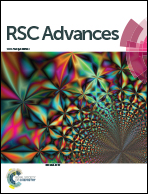Template-free synthesis of core–shell CeO2 nanospheres†
Abstract
Uniform CeO2 asymmetric core–shell nanospheres were easily synthesized via a mild template-free hydrothermal method. The results show that aggregated solid spheres transform into core–shell spheres through an Ostwald ripening process.


 Please wait while we load your content...
Please wait while we load your content...